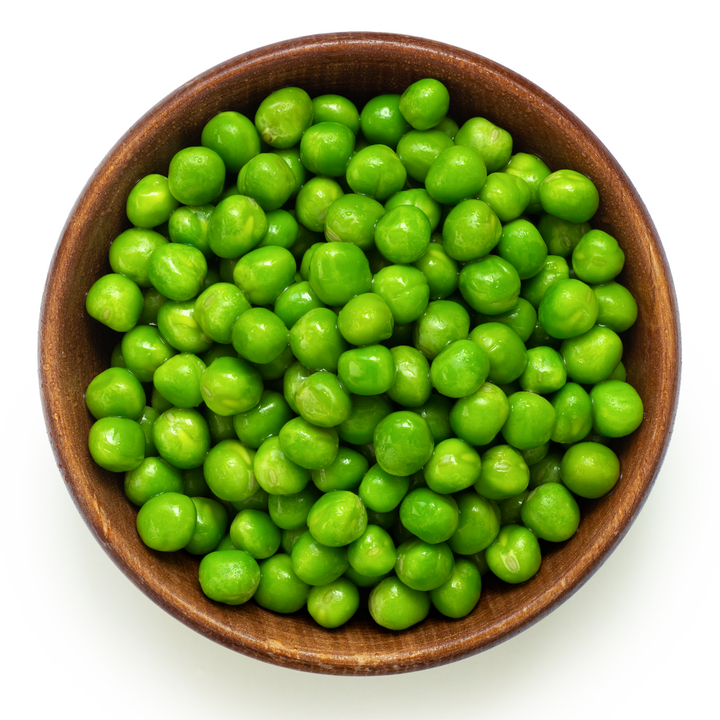Profile
Peas are among the oldest cultivated plants in the world, with the earliest finds dating back to the Stone Age. They are still a popular food and feedstuff in Austria. In recent years, however, farmers have had to contend with new challenges and a significant drop in yields. Due to the changed climate, aphids feel particularly at home and can act as carriers of a nanovirus that damages the pea and leads to yield losses.
Usage

In Austrian cuisine, peas are popular as a side dish, in soups, salads, stews or with rice in risi-bisi.
Fresh peas can be frozen, canned or dried. The latter must be soaked for about 12 hours before cooking. The so-called sugar snap peas are harvested before they are actually ripe, when the pods are still flat and the peas are still quite small. They can be eaten raw or lightly steamed.
Peas are characterized by their high protein content and are rich in vitamins, minerals and trace elements.
Peas are also used in cattle, pig and poultry feed as protein feed.
Botany
The cultivated or garden pea(Pisum sativum L.) belongs to the legume family.
The annual, summer annual or perennial plant grows its relatively thin stem into a climbing or prostrate plant. Its paired pinnate leaves run out into a branched winding tendril. The individual leaflets may be ovate to broadly elliptic or reshaped into tendrils.
The relatively large and long-stalked butterfly flowers arise from the leaf axils, which have two broad stipules. The elongated legume contains 4-10 seeds, also called peas.
The pea is divided into three subspecies. The most commonly used cultivated form is Pisum sativum subsp. sativum L.. Depending on the use, four further subspecies are distinguished:
- Forage or field pea has pink to purple flowers and dark brown seeds, which are often spotted or dotted. Mainly used as fodder, the ground, ripe peas of this subspecies are also used as green fodder and green manure.
- The pal/shell/drooping or grain pe a has white flowers and yellow or green peas. It is particularly starchy and is therefore well suited for drying (dry pea) and subsequent cooking.
- The seeds of the marrow or wrinkled pe a appear shriveled when ripe. Their sugar content makes them taste sweet and they are usually preserved as canned or frozen products.
- In the case of sweet peas or sugar snap peas, it is mainly the whole, fleshy, sweet pods with the still undeveloped seeds that are used for edible purposes.
Agricultural aspects
In Austria, 7,072 hectares of grain peas were cultivated in 2023, 20% more than in 2022, with the majority being grown in Lower Austria, Burgenland and Upper Austria. Statistics Austria reports a production volume of around 8,600 tonnes of green peas for 2023.
Peas are rather undemanding when it comes to the climate. Peas germinate at temperatures as low as 1 to 2 °C. The frost sensitivity or winter hardiness of the young plants is between -4 and -10 °C, depending on the variety; in general, winter peas are less sensitive than summer peas. A good water supply is particularly important during the flowering period, as otherwise yield losses occur due to drought stress-induced flower drop. Locations with less than 500 mm annual precipitation should therefore be avoided for cultivation if too little winter moisture - stored as soil reserves - is available.
Peas prefer medium-heavy, deep, well-drained soils without compaction and waterlogging. For optimum nodule formation, the pH value of the soil should be above 6.2.
As the peas are not self-compatible, cultivation breaks of at least 6 years must be observed. Due to the possible occurrence of Ascochyta, Sclerotinia and Botrytis (grey mould), other types of legumes as well as rape, linseed and sunflowers are also ruled out as main or catch crops. A preceding crop with good weed suppression properties should be chosen to facilitate subsequent weed control. The pea itself is considered a good preceding crop for winter cereals or summer crops such as maize and sugar beet.
As with many legumes, nitrogen fertilisation is not necessary.
Forage peas are harvested as soon as the entire crop has matured and dried, the pods are light brown and the grains are hard. Marrowfat peas are harvested while still fresh, as soon as the seeds are fully formed and sit close together in the pod. Sugar snap peas are harvested before or shortly after the pea seeds have formed, when the pods are still flat.
Grain yields are heavily dependent on rainfall and water availability and fall if there is a pronounced drought during the vegetation period. Disease, pest and virus infestation can also significantly reduce the yield level.
Development of resistant varieties
Pea cultivation in Austria has declined in recent decades, as the aphid-borne Pea Necrotic Yellow Dwarf Virus (PNYDV) has led to significant yield losses.
In our research projects, we have investigated which plants are affected, which aphid species act as vectors and which pea varieties are particularly resistant to the virus.
Last updated: 07.11.2024
automatically translated